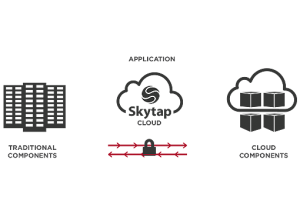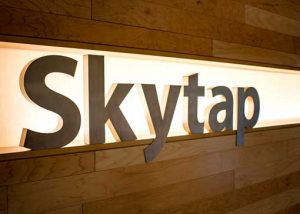The cloud continues to transform the modern enterprise. It offers the agility, flexibility, and scalability needed to develop, run, and support the applications businesses use in their operations. However, while various industry reports and surveys continue to tout the increasing adoption of cloud in the enterprise, the reality is that not all businesses have fully migrated their core applications to the cloud. And the major reason for this? Complexity. Traditional applications and workloads were, first and foremost, developed to run on physical infrastructure. Moving these applications to the cloud would mean spending significant time and resources for rewriting and re-architecting them–something that not all businesses are keen on doing. This is the reason many companies choose to pass on the opportunities the cloud brings and continue to keep their workloads on premises instead.
Skytap, a global cloud provider, seeks to help enterprises faced with such challenge. Unlike other typical cloud service providers, the company’s approach to modernization involves mirroring an enterprise’s on-premises data center environment so that traditional applications can be migrated to the cloud unchanged. This is not only faster but is also more cost-effective, allowing businesses to take advantage of new cloud architectures and processes without re-architecting.
SourceForge recently spoke with Lucas Welch, the Senior Director of Communications at Skytap, to help shed some light on the subject of the cloud and to further explain the role of the cloud in business infrastructure, migration, and application modernization.
Q: First and foremost, can you provide our readers a brief overview of Skytap and its mission? Ultimately, what drives Skytap?
A: Skytap solves a messy, urgent challenge for enterprise IT. We all know AWS, Azure, and the other hyperscale providers are compelling services for building and running new cloud-native applications. But these services combined will still be less than 25 percent of total IT spend in 2020, leaving more than 75 percent of IT budgets tied up in mission-critical applications trapped
in the data center.

Lucas Welch, the Senior Director of Communications at Skytap
Skytap Cloud frees those traditional applications from the data center and brings them into our cloud. Once there, our unique environments approach enables companies to modernize the way they manage their infrastructure, evolve development with agile and DevOps processes, and extend application architectures with new cloud services. Skytap Cloud enables customers to combine the best of their traditional apps with cloud services to create hybrid applications best suited for ongoing modernization. The end result is that our customers increase business agility and maximize existing investments.
Q: Generally speaking, how has the cloud transformed today’s business communication methods and altered traditional workflows?
A: At the peak of its hype, many hailed cloud as a revolution that would change everything. Indeed it has transformed a great deal about how we develop technology and long-term cloud will almost certainly become standard operating procedure in IT.
However, in our work with large enterprises, we see more of an evolutionary reality, versus a revolutionary one. From mainframes to AI, each generation of innovation builds on the best of what came before it. So, cloud is leveraging advances in virtualization, just as AI builds on cloud.
Cloud does fundamentally transform organizational agility. If you think of it as a graph with efficiency on one axis and velocity on another, proper use of the cloud can take you “up and to the right” – achieving major IT efficiency and development velocity gains to ultimately make a given organization a truly agile, digital entity.
Of course, this process takes time, especially when dealing with traditional enterprise applications. Cloud can give you the platform to modernize the infrastructure, processes, and architecture supporting your core business applications. We call this process IPA: infrastructure, process, and architecture. We want to help modernize infrastructure for the most important applications, process them through delivery, and implement the architecture that they can take on. The idea behind this process is that we propose the best way for enterprises to evolve and modernize in order to be better positioned in the digital economy. We see it as the leading driver of cloud’s next adoption wave targeting legacy apps.
Q: What are some typical customer myths about cloud deployment and cloud communications, and how would you respond to these?
A: I think there are two primary cloud industry myths we’d like to dispel. The first is that everyone is already in the cloud. As I mentioned before, Gartner has IT spend for 2020 at 75% non-cloud. While cloud adoption, from IaaS to SaaS, is indeed rising dramatically, we have a long way to go before “everyone’s in the cloud”. This means there are still many challenges – and, selfishly, a big opportunity for us – ahead.
The second myth I’d like to address is the idea it’s easy to migrate any application to the cloud. That’s simply not the reality. We’ve seen many an enterprise spend years and millions of dollars rearchitecting core business systems for the cloud – and still not succeed.
The problem is hyperscale clouds were built to the standard of webscale. So, they’re great for cloud-native development. But legacy apps have lots of complex dependencies to on-premises infrastructure that aren’t supported by standard clouds, especially networking, which is a particularly nasty roadblock.
Q: In your opinion, what are the most crucial factors for successful application development and deployment?
A: It goes back to my comments on infrastructure, process, and architecture modernization. All three of these areas need to evolve for enterprises to improve development velocity. Very simply, you need cloud, agile and DevOps processes – often aided by automation — and new architectures, like microservices. Transformation of this scale, depth, and importance takes time.
You need to adopt cloud to free yourself from infrastructure resource constraints and make your IT systems more efficient. This enables you to begin parallel processing development and bringing together development and operations for a more unified, transparent, and scalable approach to building software. As you evolve applications, flexible infrastructure and modern processes make it easier to adopt a microservices approach that breaks down monolithic applications into much more manageable components.
Now, in reality, there is a significant amount of trial, evolution, and nuance to this process. But, with the right tools and organizational mindset, even the largest, most traditional enterprise can become a software-driven business.
Q: What is Skytap Cloud? How does it seek to help businesses? What makes Skytap a unique competitor in the cloud market?
A: Simply put, Skytap Cloud is a global public cloud. We provide computer, networking, and storage resources for hundreds of customers around the world. Our ‘special sauce’ is the technology we’ve developed that makes us the cloud best suited for supporting the complexities of traditional enterprise applications. We’re designed to migrate and modernize enterprises’ most valuable applications in the cloud, so they can increase business agility and successfully compete in our digital economy.
Skytap Cloud enables organizations to evolve the infrastructure, processes, and architecture powering their core business applications. Applications that today are trapped on-premises because standard clouds can’t support their dependencies to on-premises resources.
Skytap Cloud is different. We enable customers to combine traditional applications with cloud-native development and services to create hybrid applications best-suited for ongoing modernization. Our environments technology makes it easy to build, run, and evolve these hybrid applications by rapidly migrating traditional workloads to the cloud, enabling modern development practices, and integrating new cloud architectures and processes.
The reality is that throwing away years of investment and innovation is often not a viable option for enterprises. Instead, their investments in traditional, mission-critical applications are best enhanced through modern technology and architecture. Businesses depend on these applications, but standard clouds are built for new development and can’t support them without significant redevelopment. Evolving these traditional applications by embracing cloud and agile development processes is the most direct path to innovation. Skytap Cloud is the platform for modernizing traditional applications through new cloud services that maximize existing investment.
Q: What sort of cost savings and productivity increases can customers expect by switching to Skytap Cloud from physical infrastructure and public clouds?
A: At the risk of sounding like a broken record, the first big benefit is the ease with which you can migrate legacy applications to our cloud. That brings its own cost and efficiency benefits.
From there, our customers parallel process development through self-service and fully-controlled cloud resources. This enables agile development processes that will significantly accelerate not just development, but overall modernization of the application portfolio. Over time, our customers become much more agile, delivering innovative software faster and cheaper, giving them a leg up on their competition.
Clicking down another level, our environments-first approach to cloud infrastructure enables IT teams to provide the self-service resources needed for agile development, while maintaining control over costs. Skytap Cloud environments can be dynamically managed to eliminate idle infrastructure. Access controls ensure usage is authorized, while auto-suspend capabilities guarantee customers only utilize capacity when environments are in use. Hundreds of customers use Skytap Cloud to accelerate release cycles, deliver new features faster, release higher quality software, and optimize IT costs.
Q: Skytap is an IBM Gold Partner. What advantages come with this status?
 A: First, access to their bare metal gives our cloud global scale. Next, They’re a fantastic sales channel and technology partner. They add significant scale to our distribution pipeline. Given our differentiation is in migrating and modernizing traditional enterprise applications, IBM is an ideal partner as their customers are basically all potential Skytap customers, as well. When you then look at IBM’s own technology, from Bluemix to Watson, there are lots of interesting paths we can add integrations to best serve customers.
A: First, access to their bare metal gives our cloud global scale. Next, They’re a fantastic sales channel and technology partner. They add significant scale to our distribution pipeline. Given our differentiation is in migrating and modernizing traditional enterprise applications, IBM is an ideal partner as their customers are basically all potential Skytap customers, as well. When you then look at IBM’s own technology, from Bluemix to Watson, there are lots of interesting paths we can add integrations to best serve customers.
It’s a thriving partnership and one you can expect to hear more about on both the technology and channel fronts in the near future.
Q: How does Skytap align with VMware? What are the advantages of this partnership?
A: It’s similar to IBM in that VMware is deeply entrenched in the enterprise datacenter and is working to give their customers a path forward to the cloud. Our ability to support traditional applications in our cloud gives their customers another strong option for modernizing their application portfolio. Not to mention we leverage some VMware technology under the hood of our cloud, so there’s also clear technology alignment.
These two elements are the primary reasons we’ve achieved Premier status within the VMware Cloud Provider Program. Together we can help enterprises accelerate delivery of the traditional applications those businesses depend on. We’re early in our partnership with VMware but see significant potential for both sides going forward.
Q: Are there any market trends, new focuses, or customer demands that you see on the rise in the cloud market?
A: From my time spent working at Chef, what we saw was that every organization wants (to some degree) to have the “Netflix credibility,” where they can release updates to their software ten times a day or more. Companies want the option to frequently (and at any given point) release an update. This is one of the big advantages of the cloud. And right now there is a lot of hype around how everything will be built in the cloud and how this is already happening…or better yet, how it is entirely imminent that everything will be moving to and using the cloud. While that’s a compelling storyline with the glitz and the glamor behind it, it is not nearly as easy to achieve. This “pitch” in favor of the cloud also involves the ability to deliver better customer satisfaction overall (regardless of industry) by delighting customers who reside in a digital economy. This is one of the myths we are trying hard to dispel.
In terms of trends, the first one we see is the reality of enterprise IT and how it belies a lot of nuances and a lot of complication and offers a narrative of rapid continuous delivery in the cloud environment. It often glosses over dealing with people and jobs and how people work together with technology, in addition to the cultural change that will happen within large organizations who have been successful with legacy equipment. You may want to be the disruptor by going to the cloud, but it is not as simple and easy as it is often made out to be. Ideally, what businesses really want is to be more effective and efficient. The primary trend here is that everyone is looking and seeing that there is a lot of new development happening, but also there are also billions and decades of innovation and development in data centers, and these have to keep pace with current developments. It is actually about addressing what is really sitting in the data centers and how we can make evolutionary gains by using principles like DevOps practices that go deep in the enterprise. The front end and the early adopters of cloud are well on their way, but how do we get to the majority and “laggers?” How do we compete and become more digital? This is a less exciting story than the lightning fast, development story often pitched in regards to the cloud and migration to the cloud.
Ultimately, It boils down to a recognition of evolution not revolution. There needs to be a more balanced approach for the late majority, and this approach needs to build on the best of what [the late adopters] have. They need to know how to get the most out of what they have with technologies like the cloud and DevOps and architecture (like containers and other modernization). At the end of the day, it is a process to bring more agility to business and is a question of how to modernize their infrastructure and architecture. Although this is a longer tale, a messier challenge, and a much more nuanced conversation, it is an important discussion to have.
Something else specifically in regards to the cloud is that we are just beginning to see the impact and consideration of AI for business. It will be really interesting to see the players in this area and the applications as well as how it is applied (in all industries).
About Skytap
Skytap is a global cloud provider focused exclusively on helping businesses leverage the cloud by modernizing their traditional enterprise applications. The provider’s primary offering, Skytap Cloud, improves business agility by enabling a quick and cost-effective migration of traditional enterprise workloads to the cloud, with no redevelopment or re-architecting required. This approach enables customers to maintain their existing investments while benefiting from modern technologies at the same time. Skytap is headquartered in Seattle, Washington and was previously backed by Amazon founder Jeff Bezos.
